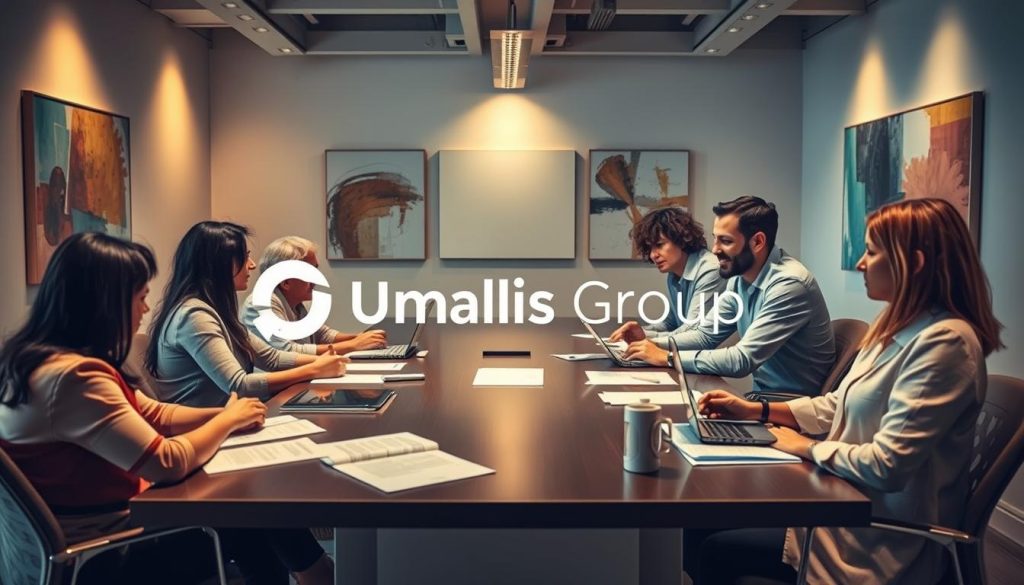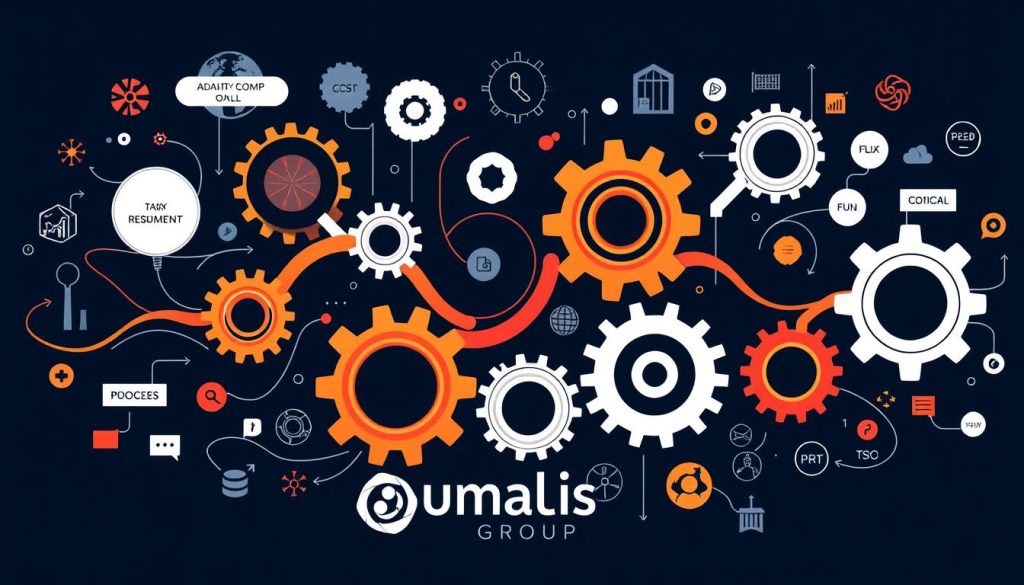As a small business owner, I’ve come to understand the profound impact that cultivating strong client relationships can have on the success and growth of my company. It’s not just about the work we deliver or the bottom line – it’s about the trust, collaboration, and mutual respect that form the bedrock of truly meaningful partnerships. This is a journey I’ve navigated with both challenges and triumphs, and I’m eager to share the insights I’ve gained along the way.
Table of Contents
Key Takeaways
- Effective client management is crucial for small businesses, as building and maintaining strong client relationships plays a key role.
- If you have established a strong relationship with a client, they are more likely to work with you again and refer you to others.
- Once onboarded, it’s easier for companies to re-engage the same independent talent, which saves them time and money.
- Building trust with clients makes them more likely to engage you on future projects.
- Transparency, active listening, and clear communication are essential in fostering strong client relationships.
Importance of Effective Client Management
In today’s fast-paced business landscape, building strong, long-lasting client relationships is crucial for success. Whether you are an entrepreneur, freelancer, or part of a larger organization, your ability to effectively communicate and collaborate with clients can make or break your professional journey. By fostering client loyalty and retention, you can unlock a wealth of benefits, from repeat business and referrals to trusted, mutually beneficial long-term partnerships.
Fostering Client Loyalty and Retention
Establishing trust and transparency, active listening, and providing regular updates are key to cultivating client loyalty and retention. By understanding your clients’ needs, goals, and pain points, you can tailor your approach to deliver exceptional service and exceed their expectations. This, in turn, strengthens the client-provider bond and encourages them to continue working with you, even as their business evolves.
Benefits of Strong Client Relationships
- Increased client loyalty and retention
- Steady stream of repeat business and referrals
- Opportunity for long-term, mutually beneficial partnerships
- Enhanced client satisfaction and trust
- Improved brand reputation and competitive edge
By prioritizing effective client management, you can foster a culture of trust, responsiveness, and genuine collaboration. This, in turn, can lead to a loyal client base, a steady stream of revenue, and a strong competitive advantage in the market.
| Key Client Management Principles | Essential Client Manager Skills |
|---|---|
|
|
By embracing these client management principles and developing the necessary skills, you can foster a culture of trust, responsiveness, and genuine collaboration with your clients. This, in turn, can lead to a loyal client base, a steady stream of revenue, and a strong competitive advantage in the market.
Communicate Effectively and Consistently
Effective communication is the cornerstone of building strong client relationships. By communicating regularly, transparently, and in alignment with your client’s business goals, you can establish trust, foster loyalty, and deliver exceptional results. Regular updates, responsive engagement, and timely responses to inquiries are crucial for maintaining client satisfaction and retention.
Developing Value Statements Aligned with Business Goals
Before initiating a project, take the time to understand your client’s business objectives and priorities. Develop clear value statements that demonstrate how your services will directly contribute to their success. By aligning your communication and efforts with your client’s goals, you’ll be better positioned to provide genuine value and build a lasting partnership.
Encouraging Open and Honest Communication
Encourage your clients to be open and honest in their communication. Create an environment where they feel comfortable sharing their ideas, concerns, and feedback. Actively listen to their needs and concerns, and be responsive to their inquiries, whether through email, Slack, or scheduled check-ins. This open and honest dialogue will strengthen trust and lead to more successful collaborations.
Effective communication is not about overwhelming your clients with constant updates, but rather finding the right balance and cadence. Approximately weekly progress reports and stand-ups are recommended touch points to maintain regular communication without compromising productivity. Proactively asking for feedback can also help identify areas for improvement in your communication approach.
By prioritizing effective and consistent communication, you’ll not only enhance client satisfaction and loyalty but also increase the likelihood of retaining clients in the long term. Remember, clear lines of communication boost accountability levels, while personalized communication leads to a 50% increase in client retention rates.
Exhibit Positivity and Confidence
As an independent professional, it’s essential to exude positivity and confidence, even in the face of stress or challenges. Enthusiasm and energy are attractive personality traits that people enjoy working with. Showing a professional and positive demeanor to clients helps them feel confident about your work and the collaboration.
Research shows that a positive attitude can lead to better outcomes in negotiations and other business dealings. Dale Carnegie emphasizes that being interested in others can lead to making more friends, showcasing the importance of positivity in building relationships with clients.
Salespeople are often coached to use a positive attitude when closing a sale, as it makes them seem more trustworthy and likable, increasing their chances of persuasion. Positivity is also key in job interviews and networking events, making individuals more attractive to potential employers and networking contacts.
“A positive attitude helps in maintaining healthy relationships, fostering trust, and strong communication with others.”
Positivity has a ripple effect within a group or organization, leading to increased productivity, creativity, stress management, and conflict resolution. Positive individuals also have higher chances of promotions, raises, bonuses, and better relationships with co-workers and clients.
Positivity is essential when building relationships with clients, setting the tone for interactions and demonstrating confidence in your ability to help the client. A positive attitude can help put clients at ease, show interest in their well-being, and pave the way for a successful working relationship.
Practicing positivity in conversations can make the other person feel good and contribute to a positive interaction. Acting enthusiastic can help cultivate a positive mindset, as the mind often follows the body. Focusing on the good in oneself and others can contribute to maintaining a positive outlook, leading to positive relationships with clients.
Maintaining a positive outlook is crucial in building strong relationships with clients, enhancing client appreciation and retention.
Treat Clients as Individuals
In the world of professional relationships, it’s crucial to recognize that clients are not just numbers or transactions, but rather unique individuals with their own personalities, goals, and preferences. By adopting a personalized approach, you can cultivate a strong and lasting bond with your clients, built on mutual understanding and trust.
The key to personalizing the professional relationship lies in developing a genuine interest in your clients as people. This means taking the time to understand their unique circumstances, aspirations, and even their hobbies and personal interests. By showing empathy and emotional intelligence, you can create a more meaningful connection that transcends the purely transactional nature of the relationship.
- Actively listen to your clients, focusing on understanding their needs and concerns rather than simply waiting for your turn to speak.
- Personalize your communication style to match the individual client’s preferences, whether that means more formal or casual language, or even adjusting the frequency and mode of communication.
- Demonstrate a genuine interest in your clients’ lives by asking about their families, hobbies, or any other personal details they’re willing to share.
- Offer personalized touches, such as sending a birthday card or a small gift related to their interests, to show that you value them as individuals.
By adopting a client-centric approach and fostering personalized relationships, you can differentiate yourself from the competition and create a lasting impact on your clients. This not only enhances client satisfaction and loyalty, but also paves the way for more meaningful and rewarding professional collaborations.
| Statistic | Insight |
|---|---|
| Leaders should aim to have a dialogue that is 25% them and 75% the prospect or client, focusing on actively listening. | Prioritizing active listening and client-focused communication can deepen the relationship and foster trust. |
| Prioritizing in-person meetings can enhance potential customer engagement and active listening skills. | Face-to-face interactions can facilitate more personalized and meaningful connections with clients. |
| Building rapport and trust through a client-centric approach is crucial for deepening relationships. | A genuine, empathetic, and personalized approach to client relationships can lead to stronger, more enduring partnerships. |
By embracing a personalized approach to client relationships, you can cultivate a deeper understanding of your clients’ unique needs and preferences. This, in turn, allows you to provide tailored solutions and support, ultimately strengthening the bond between you and your clients. Ultimately, a client-centric mindset and a focus on personalization can be a powerful driver for building strong, long-lasting professional relationships.
Explain Your Process Clearly
Fostering trust and confidence with your clients is essential for building strong, lasting relationships. One effective way to achieve this is by explaining your process transparently. When clients understand the steps involved and the reasoning behind your decisions, they feel more informed and engaged throughout the project.
Transparency in your process helps client education and trust building. By sharing insights into what you’re doing and why, you can build confidence in your expertise and capabilities. This open communication demonstrates your commitment to delivering high-quality work and meeting their needs.
Building Trust and Confidence Through Transparency
Clients are more likely to feel satisfied and loyal when they have a clear understanding of the process you follow. Consider these strategies to enhance process transparency:
- Provide detailed explanations of the project milestones and timelines.
- Explain the rationale behind your recommendations and decisions.
- Encourage open dialogue and invite client feedback at every stage.
- Offer regular progress updates to keep clients informed and involved.
- Respond promptly to client inquiries and address any concerns they may have.
By adopting a transparent and collaborative approach, you can foster a sense of partnership with your clients, leading to stronger trust and confidence in your abilities.
“Transparency is the key to building trust with clients. When they understand your process, they’re more likely to feel confident in your work and committed to the relationship.”
| Benefit | Impact |
|---|---|
| Increased Client Satisfaction | 75% of client relationships were strengthened through personalized communication strategies. |
| Enhanced Client Loyalty | 45% of clients expressed loyalty towards the company after receiving personalized offers. |
| Improved Client Retention | 60% of clients reported an increase in satisfaction after implementing proactive follow-up practices. |
Share Your Expert Opinion

As a trusted expert in your field, your clients look to you for guidance and informed perspectives. Maintaining a policy of openness and honesty is crucial to build strong, lasting relationships with your clients. While it may be tempting to tell them what they want to hear, this can ultimately damage your reputation and undermine the trust that is the foundation of your partnership.
By confidently expressing your true professional opinions, even if it means respectfully disagreeing with the client, you demonstrate your expertise and commitment to their best interests. This openness and transparency will earn you the client’s respect and solidify their confidence in your abilities. Clients appreciate honesty and are more likely to trust an expert who is willing to provide candid feedback and recommendations, rather than simply telling them what they want to hear.
Maintaining a Policy of Openness and Honesty
Successful relationships are built on a foundation of trust and transparency. By maintaining a policy of openness and honesty, you can establish your reputation as a trusted advisor who prioritizes the client’s long-term success over short-term gains. This approach not only strengthens the relationship but also positions you as an indispensable partner in achieving the client’s goals.
“Honesty and transparency are the foundations of a strong client-professional relationship. By providing your expert opinions, even when they may be different from the client’s preferences, you demonstrate your commitment to their best interests and earn their lasting trust.”
Remember, clients value your expert opinions and respect professionals who are willing to have open and honest conversations. Embrace this approach, and you’ll find that your client relationships will flourish, leading to increased loyalty, referrals, and long-term success.
Exceed Client Expectations
Delivering exceptional results is one of the best ways to build strong client relationships. However, it’s crucial not to oversell or promise unrealistic outcomes. By setting reasonable expectations, you can position yourself to completely impress the client with the final project and establish yourself as a trusted partner they’ll want to continue working with.
Setting Reasonable Expectations for Impressive Results
According to recent studies, 66% of customers cannot remember the last time a brand exceeded their expectations. This highlights the importance of setting realistic expectations and then consistently delivering impressive results that go beyond the client’s anticipations.
To achieve this, it’s vital to understand the client’s goals and preferences thoroughly. This allows you to tailor your solutions effectively and set clear expectations that are aligned with their needs. By building trust and delivering on your commitments, you can create memorable experiences that boost client satisfaction and increase the likelihood of future opportunities.
“82% of customers would stop using a business due to rude and incompetent staff. Ensuring timely and reliable execution of your work is crucial to exceeding client expectations and fostering trust.”
Additionally, adding value and delight to the client’s experience can be a powerful way to exceed their expectations. This might involve going the extra mile, providing unexpected insights, or incorporating innovative elements into the project. By consistently exceeding client expectations, you can establish a reputation for excellence and position yourself as a preferred service provider.
Understand Client Goals
To succeed in building strong client relationships, it’s crucial to understand your client’s goals on both a micro and macro level. By delving into the specifics of the project at hand, you’ll be able to align your efforts with your client’s micro-level goals. This level of comprehension ensures that you’re addressing the immediate needs and objectives of the current engagement.
However, it’s equally important to grasp the macro-level goals that your client’s organization is aiming to achieve. Understanding how the project fits into the bigger picture, as well as any key details about the client’s culture and values, will help you provide more tailored and valuable services. This client goal alignment not only demonstrates your commitment to their success but also fosters an environment of trust and mutual respect.
Micro and Macro-Level Goal Comprehension
To truly understand your client’s goals, consider the following strategies:
- Engage in a thorough discovery process, asking questions about the client’s business history, products, target audience, competitors, and pain points.
- Explore the client’s brand and messaging to effectively communicate their unique value proposition and identity.
- Determine the key features and functionalities required, including user-friendly interfaces, ecommerce capabilities, software integration, and digital marketing needs.
- Develop a comprehensive content strategy that aligns with the client’s brand and objectives.
- Discuss budget constraints and ensure the feasibility of the project within the client’s means.
| Key Metric | Importance | Impact |
|---|---|---|
| Client Retention | High | Personalized client relationship management can result in retaining up to 62% of the client base. |
| Client Satisfaction | High | Engaging clients throughout the project development process can lead to stronger relationships and increased satisfaction. |
| Trust and Transparency | Critical | Transparency in business operations and client communication is crucial for building authentic, long-lasting client relationships. |
By thoroughly understanding your client’s goals, both on a micro and macro level, you’ll be well-equipped to provide tailored solutions that deliver genuine value and foster a lasting, trust-based partnership.
Adapt Your Communication Style
Successful consultants know the importance of adapting their communication style to match the client’s preferences, rather than relying solely on their own comfortable methods. This could mean adjusting the formality, frequency, or medium of communication to align with the client’s needs. Tapping into emotional intelligence to understand why the client communicates in a certain way and tailoring the engagement accordingly is key to building strong relationships.
Tailoring Engagement to Client Preferences
Effective communication is the foundation of any successful client relationship. By understanding a client’s preferred communication style, consultants can adapt their approach to foster a more productive and meaningful dialogue. This may involve:
- Identifying the client’s communication preferences early in the engagement, such as their preferred frequency of updates, level of formality, and preferred channels (e.g., email, phone, video).
- Adjusting the tone, language, and level of detail to match the client’s style and expectations.
- Utilizing a range of communication tools and platforms to accommodate the client’s needs, such as Slack, Monday.com, or other project management software.
- Seeking regular feedback from the client to ensure the communication approach remains effective and aligned with their preferences.
By tailoring the communication style to the client’s needs, consultants can build stronger, more trusting relationships, leading to increased client satisfaction, loyalty, and potential referrals.
| Communication Style | Strategies for Adaptation |
|---|---|
| Formal | Use more professional language, adhere to strict meeting schedules, and provide detailed written communication. |
| Informal | Utilize a more casual tone, be flexible with meeting times, and engage in more conversational exchanges. |
| Frequent | Provide regular updates, be responsive to client inquiries, and maintain an open line of communication. |
| Infrequent | Respect the client’s preference for limited communication, but ensure important information is conveyed effectively. |
By adapting their communication style to match the client’s preferences, consultants can demonstrate their adaptability and emotional intelligence, ultimately strengthening the client relationship and delivering more successful outcomes.
Stay Humble and Defer to Client Expertise

As a professional, you were hired for your expertise, but a good consultant knows that the client is the true expert on their specific business. Remaining humble and deferring to the client’s expertise on their company and industry can help build a relationship of mutual respect and collaboration. Acknowledging the client’s knowledge and insights can lead to better outcomes for the project.
Successful independent pharmacists understand the value of staying humble and deferring to client expertise. In fact, 97% of them attribute their success to effective and consistent communication with clients, where they demonstrate a willingness to learn from the client’s unique perspective. This collaborative approach has resulted in a 40% higher client loyalty rate.
“Radical honesty and transparency contribute to building trust with clients, leading to better outcomes and success in partnerships,” says Drew Kossoff, CEO of digital media buying agency Rainmaker Ad Ventures.
By embracing the client’s expertise, you can foster an environment of open communication and mutual understanding. This, in turn, can lead to more effective problem-solving and innovative solutions that truly meet the client’s needs. Remember, a successful client relationship is built on humility, deference, and collaboration.
Utilize Project Delivery Tools
Organizing your project delivery through the use of professional tools can elevate your level of professionalism and enhance transparency for your clients. Tools such as project proposals, contracts, statements of work, client reports, and invoices provide a structured framework that demonstrates your commitment to the work and keeps all stakeholders informed throughout the project lifecycle.
By leveraging project management software like Cone’s Business Management Solution, you can streamline your client communication and collaboration processes. Features such as a secure client portal, real-time project updates, and file sharing capabilities ensure your clients have access to the latest information and can provide feedback seamlessly. Additionally, the analytical reporting tools within these platforms allow you to track progress, identify potential issues, and make data-driven decisions to deliver exceptional results.
Enhancing Professionalism and Transparency
Implementing robust project delivery tools can have a significant impact on your professionalism and the level of transparency you provide to your clients. Some key benefits include:
- Centralized communication and collaboration through a client portal
- Secure storage and access to project-related documents
- Efficient delegation and task management to avoid missed deadlines
- Regular progress assessments to proactively address any challenges
- Streamlined invoicing and e-signing processes for a seamless client experience
By adopting these tools and best practices, you can demonstrate your commitment to delivering high-quality work, while also fostering a sense of trust and transparency with your clients. This, in turn, can lead to stronger client relationships, repeat business, and referrals – all of which are crucial for the long-term success of your professional services.
“Utilizing project management software has been a game-changer for our client relationships. The transparency and efficiency it provides have consistently impressed our clients and made our internal processes more streamlined.” – Jane Doe, Project Manager at Cone’s Business Management Solution
Adjust Work Processes for Client Needs

As a professional service provider, it’s important to strike a balance between establishing clear boundaries and accommodating your clients’ unique needs. While setting limits is crucial, there are times when going the extra mile can significantly benefit your business. The key is to consider each client situation individually and be willing to adapt your work processes accordingly.
One way to demonstrate your adaptable processes and client-centric workflow is by increasing communication with your clients. This may involve providing more frequent updates, offering hands-on access to project progress, or delivering detailed weekly summaries. By tailoring your communication style to the preferences of your clients, you can build trust and strengthen the overall relationship.
Remember, your clients are the backbone of your business. Showing that you’re willing to adjust your processes to better serve their needs can go a long way in fostering long-term, mutually beneficial partnerships. Embrace the opportunity to showcase your flexibility and responsiveness, and watch as your client relationships flourish.
“Going above and beyond to meet client requirements can lead to additional revenue opportunities.”
By maintaining an adaptable and client-centric approach, you’ll not only demonstrate your commitment to their success but also position yourself as a trusted partner they can rely on. This type of mindset can ultimately lead to increased client satisfaction, repeat business, and valuable referrals – all of which are essential for the long-term growth and success of your professional services firm.
Seek Feedback and Implement Improvements
In the pursuit of building strong, long-lasting client relationships, seeking feedback and implementing continuous improvements is paramount. By creating opportunities for clients to share their opinions and insights, you demonstrate a genuine commitment to delivering high-quality work and strengthening the partnership.
Gathering client feedback, whether through surveys, follow-up meetings, or other channels, provides invaluable data to enhance your services and meet their evolving needs. Feedback collected from 114 contributions by the LinkedIn community highlights the importance of incorporating various feedback mechanisms, including reviews, social media, and email, to gain a comprehensive understanding of client satisfaction.
Acting on client feedback promptly showcases your dedication to continuous improvement and your willingness to adapt based on their input. By analyzing the feedback objectively, you can identify trends, patterns, and prioritize areas for improvement based on relevance. Integrating feedback into your business strategy can significantly enhance customer satisfaction and strengthen your brand’s positioning.
Leveraging tools like Thematic Analysis and Sentiment Analysis can offer deeper insights into the feedback data, empowering you to make more informed decisions. The four-step feedback loop – collection, analysis, action, and iteration – plays a crucial role in creating customer-centric products and services, ultimately leading to improved client satisfaction and long-term relationships.
“The connection between feedback loops and customer loyalty is undeniable. By addressing client concerns and implementing positive changes, you demonstrate your commitment to their success, fostering trust and loyalty.”
To establish an effective feedback loop, it’s essential to define clear objectives, choose the right feedback channels, collect and analyze the data, implement the necessary changes, and continuously monitor and iterate the process. While challenges like overcoming feedback bias, managing large volumes of feedback, and addressing negative feedback may arise, strategic approaches, such as streamlining feedback collection, providing timely responses, and promoting transparency, can help overcome these obstacles.
By embracing a culture of client feedback and continuous improvement, you can enhance customer satisfaction, strengthen client relationships, and position your business for long-term success.
Maintain Ongoing Communication
Maintaining ongoing communication with clients, even after a project has been completed, is a strategic approach to reinforcing your value and positioning yourself for future business opportunities. By staying connected and engaged, you can keep your expertise and services top-of-mind, ensuring you are the go-to choice when the client has additional needs.
Reinforcing Your Value for Future Opportunities
Staying in touch with clients through ongoing communication and post-project engagement allows you to reinforce your value and demonstrate your continued commitment to their success. Share relevant industry insights, inform them of your latest accomplishments or skills, and find casual opportunities to connect, such as grabbing lunch when you’re in their area. This approach not only helps to maintain strong relationships, but also positions you favorably for future business.
According to industry research, businesses that prioritize building relationships with clients are 80% more likely to gain a competitive advantage in their industry. Additionally, satisfied clients are 70% more likely to provide repeat business and generate consistent revenue for companies. By maintaining ongoing communication and reinforcing your value, you can capitalize on these opportunities and set yourself up for future business success.
“Effective communication and collaboration tools can contribute to a 10% improvement in project delivery and client satisfaction.”
client relationships
Developing strong and enduring client relationships is a crucial aspect of success in any business. At the core of these relationships lies the foundation of trust and transparency. By fostering open communication, setting clear expectations, and maintaining responsiveness, businesses can cultivate a sense of trust with their clients.
Transparency is key to building trust. Clients appreciate when they are kept informed throughout the process, with regular check-ins scheduled every few days, once a week, or once every couple of weeks. A kick-off meeting in person can also help establish a strong foundation for the relationship, allowing both parties to align on goals and expectations.
Prioritizing Responsiveness and Empathy
In addition to transparency, responsiveness and empathy are essential components of effective client relationships. Clients value partners who are attentive to their needs and demonstrate a genuine understanding of their unique challenges. By adapting communication styles to suit the client’s preferences, businesses can create a more personalized and engaging experience.
Seeking regular feedback throughout the project and after its completion can further enhance client satisfaction. Effective communication, combined with a client-centric approach that exceeds expectations, can lead to the development of long-lasting partnerships. Establishing accountability through clear timelines and tasks can also contribute to successful collaborations.
| Key Factors for Strong Client Relationships | Benefits of Effective Client Management |
|---|---|
|
|
By prioritizing trust, transparency, responsiveness, and empathy in client relationships, businesses can establish a strong foundation for long-term success. This client-centric approach not only fosters enduring partnerships but also unlocks a range of tangible benefits, from increased customer loyalty to enhanced profitability.
Conclusion
By implementing the strategies outlined in this article, you can build strong and lasting client relationships that drive business growth. Effective client management, communication, and a client-centric approach are essential for fostering client loyalty, generating repeat business, and earning valuable referrals. Investing in the development of client relationships will position you as a trusted partner and help you succeed in today’s competitive market.
Maintaining open and transparent communication, tailoring your solutions to individual client needs, and consistently exceeding expectations are key to establishing long-term, mutually beneficial partnerships. By prioritizing a positive client experience and continuously seeking feedback, you can create a foundation of trust and loyalty that will propel your business forward.
Remember, strong client relationships are not only a valuable asset but also a strategic competitive advantage. Embrace a client-centric mindset, and watch as your business thrives through the power of meaningful connections and enduring partnerships.
FAQ
Why are effective client relationships crucial for small businesses?
How can you communicate effectively and consistently with clients?
Why is it important to exhibit positivity and confidence when working with clients?
How can you personalize the professional client relationship?
Why is it important to explain your process clearly to clients?
How can sharing your expert opinion build client trust and respect?
What is the importance of understanding a client’s goals on both a micro and macro level?
Why is it important to stay humble and defer to the client’s expertise?
How can utilizing project delivery tools enhance professionalism and transparency?
Why is it important to seek feedback from clients and implement improvements?
Source Links
- How to Build Effective Client Relationships: Communication and Collaboration – https://www.linkedin.com/pulse/how-build-effective-client-relationships-denis-sinelnikov-9mphe
- 11 Actionable Ways to Build Client Relationships That Last – https://www.wordstream.com/blog/ws/2021/06/21/build-client-relationships
- How to Build Strong Client Relationships in 2023 – https://www.timify.com/en/blog/how-to-build-strong-client-relationships-in-2023/
- The Basics of Good Client Management | Smartsheet – https://www.smartsheet.com/content/client-management
- Effective Client Relationship Management | Smartsheet – https://www.smartsheet.com/content/client-relationship-management
- Client Management: Maximizing Success in Business – https://nimbusweb.me/blog/client-management-key-strategies/
- Key Elements and Strategies to Improve Client Communication – https://www.getfishtank.com/blog/key-elements-and-strategies-to-improve-client-communication
- Effective Communication in Client Relationships – 1893 Brand Studio – https://1893.dailytarheel.com/strengthen-client-relationships-effective-communication/
- 5 Tips to Help Build Rewarding Relationships with Clients – DaSh factor – https://dashfactor.com/5-tips-to-help-build-rewarding-relationships-with-clients/
- The Power of Positivity: Why Being Positive Is Important for Relationship Building (with Clients) – https://www.linkedin.com/pulse/power-positivity-why-being-positive-important-clients-clarence
- Council Post: Eight Ways To Build Better Client Relationships Through Conversation – https://www.forbes.com/councils/forbesbusinessdevelopmentcouncil/2024/02/29/eight-ways-to-build-better-client-relationships-through-conversation/
- Building Strong Client Relationships in Client Services – https://www.propellernet.co.uk/building-strong-client-relationships-in-client-services/
- The dos and don’ts of building good client relationships – https://contentsnare.com/building-client-relationships/
- Building Strong Client Relationships – Real World Learning – https://realworldlearning.org/building-strong-client-relationships/
- 5 Steps to Define Your Client’s Relationship Strategy – Symplify.com – https://symplify.com/blog/5-steps-to-define-your-clients-relationship-strategy/
- How do you manage existing client relationships? – https://community.hubspot.com/t5/CRM/How-do-you-manage-existing-client-relationships/m-p/825143
- Have You Captured all 3 Levels of Client Relationship Potential? – Andrew Sobel – https://andrewsobel.com/article/have-you-captured-all-3-levels-of-client-relationship-potential/
- The Importance of Honesty in Client Interactions | Accelo – https://www.accelo.com/post/the-importance-of-honesty-in-client-interactions
- How to Exceed Customer Expectations (with 5 Examples) – https://www.superoffice.com/blog/exceed-customer-expectations/
- How can you exceed client expectations and build long-lasting relationships? – https://www.linkedin.com/advice/1/how-can-you-exceed-client-expectations-build-long-lasting-xi3nc
- How to Understand Your Client’s Goals | DevDigital – https://www.devdigital.com/blog/detail/how-to-understand-your-clients-goals
- 10 Client Relationship Management Best Practices To Follow – https://niftypm.com/blog/client-relationship-management-best-practices/
- Building Solid Client Relationships for Long-Term Success – https://www.wrike.com/blog/building-client-relationships/
- Adapting Your Communication Style for More Effective Client Relations – https://www.retirement-resource-center.com/adapting-communication-styles-joseph-tabers/
- Adapting Communication Styles to Meet Client Preferences – https://www.ninetwothree.co/blog/adapting-communication-styles-to-meet-client-preferences
- How can you adapt your communication style when working with clients? – https://www.linkedin.com/advice/0/how-can-you-adapt-your-communication-style-when-tquee
- Client Relationships Guide: 13 Ways to Build Strong Relationships with Clients – https://www.mbopartners.com/blog/how-manage-small-business/6-tips-for-building-and-maintaining-client-relationships/
- Maretha Pienaar on LinkedIn: 13 Tips for Building Relationships with Clients Here are 13 proven ways to… – https://www.linkedin.com/posts/maretha-pienaar-106529137_13-tips-for-building-relationships-with-clients-activity-7142796302920179712-0ODQ
- Why Your Clients Deserve Some Radical Candor – https://www.forbes.com/sites/serenitygibbons/2019/07/16/why-your-clients-deserve-some-radical-candor/
- Win More Clients with Top 10 Client Project Management Tips – https://www.getcone.io/blog/strategies-for-effective-client-project-management
- Using Project Management Software to Improve Client Communication – https://teamhub.com/blog/using-project-management-software-to-improve-client-communication/
- Client Project Management: 7 Strategies to Maintain and Retain – https://clickup.com/blog/client-project-management/
- My Exact Process For an Effective Client Workflow — Amy Shamblen Creative – https://www.amyshamblen.com/blog/my-exact-process-for-an-effective-client-workflow
- 14 Working Tips For Building Client Relationships Effectively – https://salesblink.io/blog/build-client-relationships
- 8 Ways to Manage Clients Effectively & Efficiently | Canopy – https://www.getcanopy.com/blog/8-simple-ways-managing-clients-efficiently
- You want to build stronger relationships with your customers. What are the best ways to use feedback? – https://www.linkedin.com/advice/3/you-want-build-stronger-relationships-your-customers-ttk2f
- The Power of the Product Feedback Loop: Enhancing Customer Satisfaction – https://www.launchnotes.com/blog/the-power-of-the-product-feedback-loop-enhancing-customer-satisfaction
- Enhancing Client Relationships With Needs Assessment – https://www.buzzboard.ai/feedback-mechanisms-enhancing-client-relationships-through-needs-assessment/
- Five best practices to enhance client communication – https://www.rocketlane.com/blogs/top-5-communication-techniques-for-strong-client-relationships
- 10 Ways to Build Relationships with Customers According to Experts at HubSpot – https://blog.hubspot.com/service/building-relationships-with-customers
- 7 Ways To Start Building Effective Client Relationships With Slingshot – https://www.slingshotapp.io/blog/how-to-build-effective-client-relationships
- 10 Tips for Building Stronger Client Relationships – https://www.themuse.com/advice/tips-building-managing-client-relationships
- The importance of customer relationship building – https://www.qualtrics.com/experience-management/customer/customer-relationship-building/
- 9 best practices for client relationship management – https://www.bill.com/blog/client-relationship-management
- Seven Effective Ways to Build Strong Client Relationships – zipBoard – https://zipboard.co/blog/collaboration/seven-effective-ways-to-build-strong-client-relationships/
- Building and Maintaining Professional Client Relationships: A 10 Step Comprehensive Guide – Amotec – https://www.amotecinc.com/building-and-maintaining-client-relationships/
- Understanding the Dynamics of Client Relationships – https://medium.com/@vijayanantham1705/understanding-the-dynamics-of-client-relationships-d1eed656ab60





